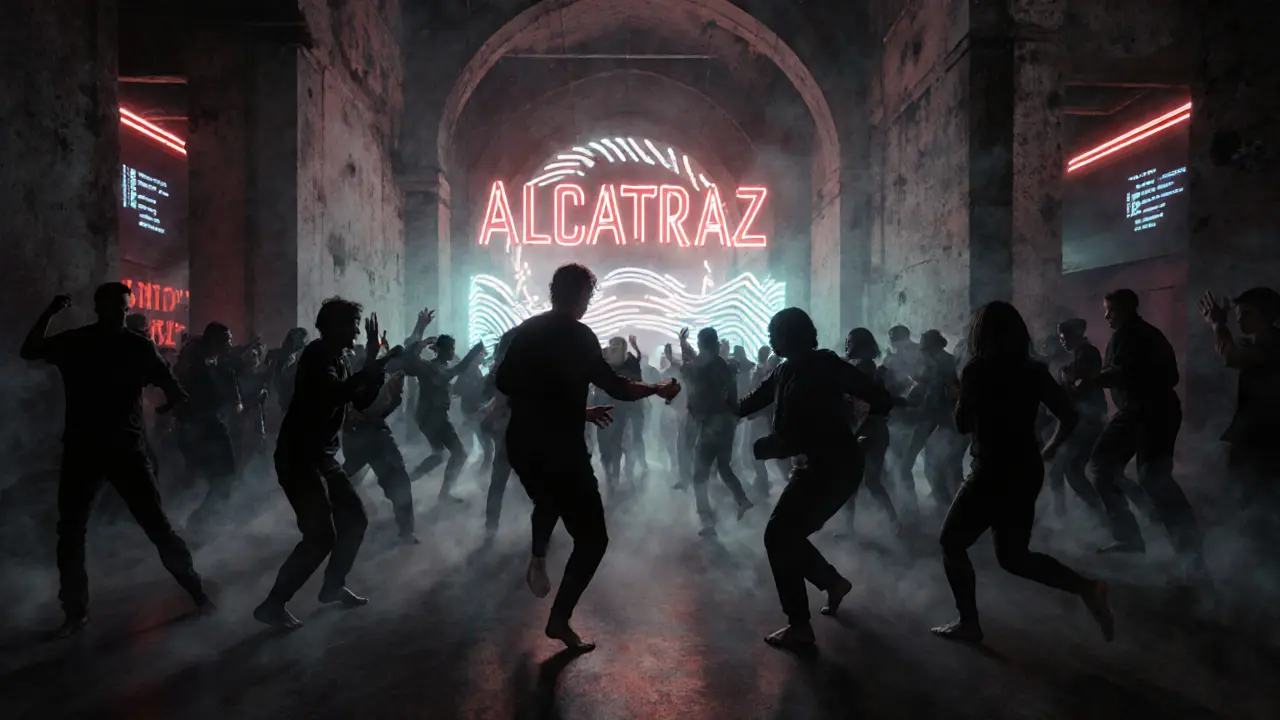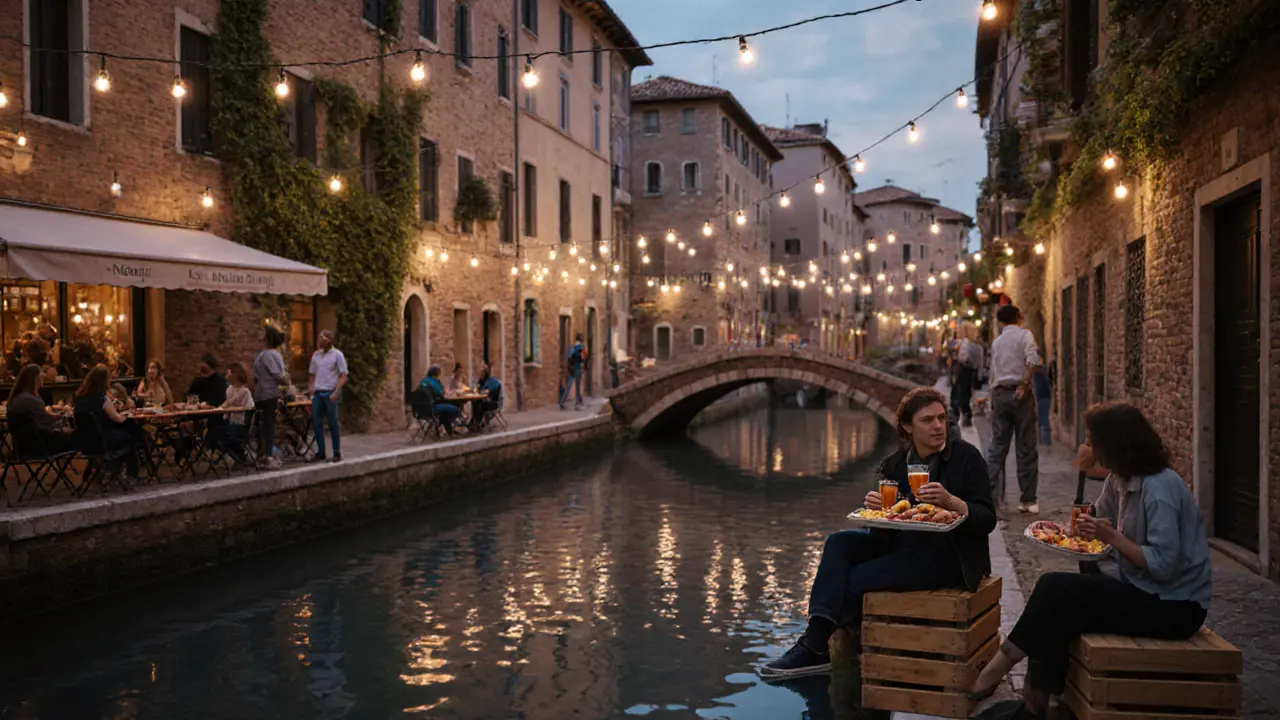Milan doesn’t sleep when the sun goes down. While it’s famous for fashion and design, the city’s real pulse kicks in after 9 p.m. You won’t find neon-lit strip malls or tourist traps here. Instead, you’ll find hidden courtyards with live jazz, rooftop bars with skyline views, and underground clubs where DJs spin techno until sunrise. This isn’t just about drinking-it’s about the rhythm of the city, the way people gather, laugh, and move through the night.
Start with Aperitivo: Milan’s Nightlife Ritual
If you think dinner starts at 8 p.m., you’re already late. Milan’s real night begins at 7 p.m. with aperitivo. It’s not just a drink-it’s a tradition. For €10 to €18, you get a cocktail or glass of wine and a buffet of snacks that rivals a full meal. Think arancini, stuffed tomatoes, cured meats, and mini lasagna. Places like Bar Basso a legendary bar in the Navigli district known for inventing the Negroni Sbagliato and Terrazza Aperol a vibrant rooftop spot with panoramic views of the Duomo turn this into an all-night affair.
Don’t skip the Navigli canals. The water reflects the string lights, and locals spill out of bars onto the sidewalks. You’ll hear Italian, French, and English mixing. People sit on crates, share bottles, and talk for hours. This is where Milanese unwind-not in clubs, but in the open air, surrounded by history.
Navigli: The Canals That Never Sleep
Navigli isn’t one place-it’s a network of canals lined with over 200 bars, wine shops, and live music venues. The area splits into two vibes: the western end near Porta Genova is artsy and relaxed, perfect for craft beer and vinyl nights. The eastern stretch, closer to the city center, gets louder, with DJs spinning house and disco.
Try La Bicocca a cozy spot with 30+ Italian wines by the glass and a backyard garden for a quiet start. Then head to Il Gatto Nero a basement club with rotating DJs and a crowd that’s all about the music, not the labels. It’s not flashy. No velvet ropes. No bouncers checking your outfit. Just good sound and a crowd that knows how to move.
Weekends here get packed. Arrive before 10 p.m. or expect to wait. But if you’re patient, you’ll find the real Milan-locals dancing barefoot on wooden floors, laughing over shared plates of fried zucchini flowers.
Brera: Where Art Meets After Hours
Brera feels like a secret. Narrow cobblestone streets, old bookstores, and galleries that close at 7 p.m. But at night, it transforms. The bars here are intimate-think candlelit terraces, whiskey bars with rare bottles, and jazz clubs tucked into former palazzos.
Alba a minimalist bar with a focus on Italian gin and tonics, made with local botanicals is a favorite among designers and artists. Order the “Milanese Negroni”-it’s made with a house bitters blend that’s been aging for three years.
For live music, La Sala delle Colonne a 19th-century hall turned jazz venue, where musicians play without microphones, relying on acoustics alone is unbeatable. No cover charge. No reservations. Just a small crowd, a piano, and a saxophone that sounds like it’s breathing.
Brera doesn’t scream for attention. It whispers. And if you listen, you’ll hear why it’s the soul of Milan’s night.

Porta Venezia: The City’s Most Diverse Night
Forget the glossy clubs downtown. Porta Venezia is where Milan’s real diversity lives. This neighborhood is home to immigrants from Africa, South Asia, and Eastern Europe-and their nightlife reflects it. You’ll find Ethiopian bars with live drumming, Pakistani shisha lounges, and LGBTQ+ spots that feel like family.
Bar Rosso a colorful, no-frills bar with karaoke nights and cocktails named after Italian films is a local legend. The bartender knows your name by the third visit. La Vela a rooftop bar with views of the city skyline and a playlist that mixes Afrobeat and Italo-disco draws a crowd that’s young, bold, and unapologetically themselves.
This is where you’ll find the most unexpected nights. A DJ from Lagos spinning tracks next to a group of Milanese students. A group of queer friends dancing under fairy lights. No one cares what you wear. They care that you’re here.
San Babila and the Club Scene: When Milan Gets Loud
If you want bass you can feel in your chest, head to San Babila. This is Milan’s answer to Berlin’s techno scene. Clubs here don’t open until midnight. They don’t advertise. You find them by word of mouth.
Alcatraz a former church turned industrial club, known for underground techno and experimental sets is the temple. The walls are concrete. The floor is sticky. The sound system is so powerful it vibrates your ribs. You won’t find a drink menu. Just a bar with beer, water, and espresso shots to keep you going.
For something more polished, try Magazzini Generali a multi-level venue with three distinct rooms: one for house, one for hip-hop, and one for live electronic performances. It’s open until 6 a.m. on weekends. The crowd? Mix of Milanese, Berliners, and tourists who know where to look.
Do not expect VIP tables or bottle service. This isn’t about showing off. It’s about losing yourself in the music.

What to Wear and How to Get Around
Milan’s nightlife doesn’t care about your brand name. But it does care about how you carry yourself. You don’t need a suit. But you should avoid sweatpants and flip-flops. Clean jeans, a good shirt, and closed shoes work everywhere. At Alcatraz? Black is the uniform. At Navigli? Anything goes.
Public transport shuts down at 1:30 a.m. After that, you’ll need a taxi or rideshare. Uber works, but local apps like FreeNow and Beat are cheaper. Walking is safe in central areas like Brera and Navigli-but avoid the outskirts after midnight. Stick to well-lit streets.
Most clubs don’t charge cover before midnight. After that, it’s €10-€20. Some places take cash only. Always carry €20-€30 in small bills.
When to Go: Seasonal Secrets
Summer (June-August) is the peak. Navigli overflows. Rooftops are packed. But it’s also the hottest and most crowded.
Spring (April-May) and fall (September-October) are ideal. The weather is perfect for outdoor aperitivo. Crowds are thinner. The vibe is more relaxed.
Winter (November-February) is quiet-but don’t write it off. Christmas markets turn into late-night pop-up bars. Clubs like Alcatraz host special themed nights. And the locals? They know the best spots. Ask them.
Final Tip: Talk to Locals
The best night in Milan isn’t on Instagram. It’s not in a travel blog. It’s the bar you walk into because someone smiled at you and said, “Vieni con me.”
Ask the bartender what they’re listening to. Ask the waiter where they go after their shift. Ask the girl dancing alone in the corner if she knows a place with live percussion. You’ll get five different answers. All of them will be right.
Milan’s night doesn’t belong to the tourists. It belongs to the people who show up, stay late, and let the city move them. Be one of them.
What time do bars and clubs open in Milan?
Most bars open for aperitivo around 7 p.m. Clubs typically open at midnight and stay open until 2-6 a.m., depending on the night and location. Weekend clubs like Alcatraz and Magazzini Generali often run until sunrise.
Is Milan nightlife safe for solo travelers?
Yes, Milan’s main nightlife districts-Navigli, Brera, Porta Venezia, and San Babila-are generally safe for solo travelers, especially in well-lit, busy areas. Avoid walking alone in industrial zones or near train stations after midnight. Use rideshares if you’re tired or unsure. Most locals are friendly and happy to help.
Do I need to book tables in advance?
For aperitivo spots like Terrazza Aperol or Bar Basso, booking ahead is smart on weekends. For clubs, most don’t take reservations-just show up. Some venues like Magazzini Generali allow online booking for special events, but walk-ins are always welcome.
What’s the average cost for a night out in Milan?
Aperitivo costs €10-€18 and includes food. A cocktail at a trendy bar runs €12-€16. Club cover charges are €10-€20 after midnight. Drinks inside clubs are €8-€12. A full night out-including transport and food-can cost €40-€80 depending on your choices.
Are there any dress codes in Milan clubs?
Most clubs have no strict dress code, but smart casual works best. Avoid sportswear, flip-flops, or overly casual outfits. At Alcatraz, black clothing is common. At Porta Venezia, self-expression is encouraged. When in doubt, dress to feel confident-not to impress.
